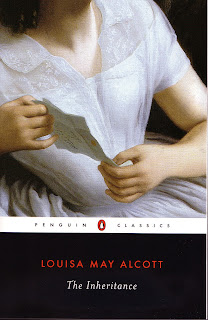When one thinks of Louisa May Alcott, Little Women is surely to come to mind. While this is undoubtebly Alcott’s most infamous work, would be readers might be surprised to learn that she authored well over fifty works, including works of fiction, plays, short stories, and poetry. One particular work was produced in 1849,(though unpublished until 1997) when Alcott was just seventeen years of age! This work was The Inheritance.
At its heart, The Inheritance is a sentimental fairy tale, full of romance, suffering, and characters so pure and noble that they only exist in fiction. The story details the Hamilton family and, more specifically, the family ward, Edith Adelon. Edith is a somber, yet good natured, Italian girl who was brought to the family by the late Lord Hamilton. While traveling in Italy, he came across this beautiful young waif singing sweetly in the yard of her orphanage. He was warmed by her friendless situation, as well as her fair face and lovely voice, so he brought the young girl to live with his family in England and serve as a companion to his young daughter Amy. The story commences in the present day, where readers are introduced to all of the unique personalities that inhabit the Hamilton manor. There are the two young Hamiltons, Amy and Arthur, who are praised for their good natures and benevolent spirits. Their mother, Lady Hamilton, is a stern, discerning woman, though she is capable of great love and warmth in regards to her kin. Lady Ida Clare, the niece of Lady Hamilton, is a prideful and frigid woman who—though once rather beautiful—fears that she is loosing her beauty in her old age and thus resents the docile charms and good looks of Edith. As the story begins, the Hamiltons are awaiting the arrival of Arthur’s dear friend, Lord Percy, who he praises as the noblest man he has ever known. Upon Lord Percy’s arrival, a string of events are set forth which in turn lead this story down the road of jealously, unrequited love, and the all encompassing theme that praises kind and gentle hearts to win favor over all others.
This story really does read like a fairytale, and I found it to be rife with flowery prose and noble sentiments typical to most fairytales. In many ways, this could seem a turn off for some. The characters could easily be classified as stock characters, as most of them hold only one outstanding trait and very little true character development is seen amongst the pages. Even I, who am well acquainted with the Fairy Tale genre, found the constant need to praise Edith’s heart, beauty, and voice to be a tad too much. However, when viewed as a sort of American fairytale, these perceivable flaws are mostly forgiven. While Edith could come off as what is known as a Mary Sue—an unrealistic, wish fulfillment heroine—, when read as a fairytale, the otherwise overbearing repetition of her kind and pure character become charming and romantic. The narrative of The Inheritance reads similar to stories like A Little Princess by Frances Hodgson Burnett and The Princess and the Goblin by George MacDonald. While I personally find more depth in Burnett’s work, one cannot deny the charm of this little known Alcott gem. If you’re in the mood for a romantic fairytale, put the Disney away and give The Inheritance a try. It is very much a Young Adult book, and as such is a quick and easy read for even the most time pressed individual.
Rating: 3/5


No comments:
Post a Comment